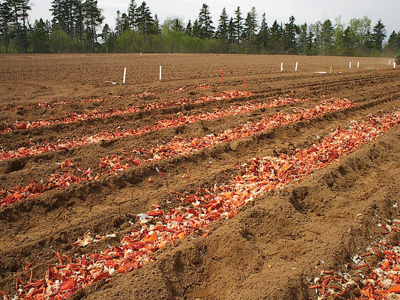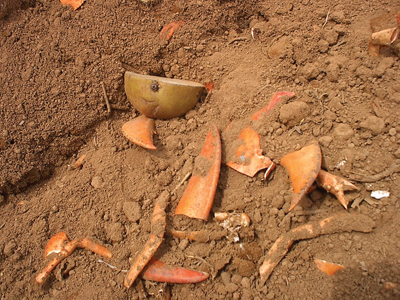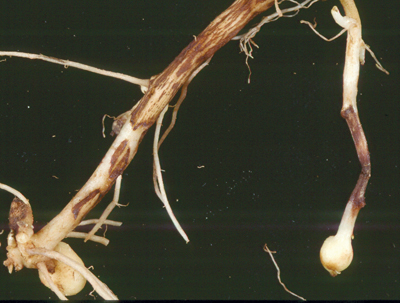
Features
Agronomy
Other Crops
Seafood waste – a valuable agricultural commodity?
The first association between lobster and potatoes may be how they are best served together on a dinner plate, yet new research is showing that lobster and potatoes can be associated in more valuable ways. “Every year in the Maritimes,” says Dr. Rick Peters, “processing waste from seafood products, particularly lobster, must be disposed of. With this disposal comes certain environmental risks.”
April 6, 2009 By Treena Hein
The first association between lobster and potatoes may be how they are best served together on a dinner plate, yet new research is showing that lobster and potatoes can be associated in more valuable ways. “Every year in the Maritimes,” says Dr. Rick Peters, “processing waste from seafood products, particularly lobster, must be disposed of. With this disposal comes certain environmental risks.”
Using this processing waste in a positive way would therefore be a win-win situation for the seafood industry, the environment and, as it turns out, for the organic potato industry as well.
Since 2001, Peters, a scientist at Agriculture and Agri-Food Canada’s Crops and Livestock Research Centre in Charlottetown, Prince Edward Island, has undertaken studies at Harrington Research Farm, which is also on the Island. He has co-ordinated much of his work with J.A. MacLeod, a retired scientist with AAFC, A.V. Sturz, strategic planning specialist with the Executive Council Office, Government of Prince Edward Island. They have worked to determine the suitability of raw and composted lobster processing waste as a soil amendment in organic potato production.
“We also wanted to investigate the potential of this waste for control of rhizoctonia and other pathogens,” says Peters. “Lobster shells are made of chitin, as are the cell walls of many fungal pathogens of potatoes. We hypothesized that adding the shells to the soil would stimulate local populations of beneficial bacteria and fungi that would break down and decompose the shell material and at the same time antagonize the pathogens that were made from the same material.”

|
|
| Seafood waste lying in the field. | |
 |
|
| Seafood waste near potato-seed piece. | |
 |
|
| Germinated potato plant with bleached lobster waste. | |
 |
|
| The disease the waste is to combat; rhizoctonia stem and stolon canker.
|
Annual experiments
Field trials since 2001 featured plots with raw or composted lobster waste applied in-furrow or broadcast on the plot surface and incorporated. Control plots received synthetic fertilizer (15-15-15), and all plots received the equivalent of 60 kg N/ha (about 54 lbs/ac)
Cut potato seed of the Superior Elite 2 variety infested with sclerotia of Rhizoctonia solani was then hand-planted in all plots. In each year of study, one of the centre two rows of each plot was used for destructive sampling of plant tissues while the other row was harvested for yield and tuber assessments. “All trials have been maintained using organic protocols,” says Peters, “which included the use of cultivation for weed control, copper hydroxide (Kocide) for late blight control and Bacillus thuringiensis (Novador) for control of Colorado potato beetles.”
Each year, researchers measured canopy colour intensity at various times during the summer using a chlorophyll meter. They also took plant samples in July and August and rated them for stem canker caused by R. solani. “We recorded tuber masses and number of potatoes falling into each grade, as well as total yield for each experimental plot,” notes Peters.
In terms of disease control observations, the research team rated 50 tubers from each harvested row for severity of black scurf (R. solani), silver scurf (Helminthosporium solani), dry rot (Fusarium spp.) and common scab (Streptomyces scabiei). Finally, selected tubers from each plot were inoculated with various phytopathogens in order to discover whether any intrinsic disease suppression was apparent in plots receiving lobster waste.
Soil samples from the root zone taken in July were assessed in terms of their microbial populations, and harvested tubers were surface-sterilized and then evaluated for endophytic microorganisms (those that have a positive effect on plant growth).
Results promising
“Overall,” observes Peters, “our results were very positive. They support the belief that raw lobster waste may be useful as an organic amendment for crop nutrition, since it compared favourably with synthetic fertilizer in our trials. In terms of disease control, we found that lobster waste used as a soil amendment clearly altered soil and tuber microbial populations in favour of those that were both chitinolytic and antagonistic to soil-borne potato pathogens.”
Emergence was excellent in all plots, with the exception of those that received raw lobster waste in-furrow during some years. Peters says that treatment can be phytotoxic if the organic material is applied too close to the seed piece. “With careful placement of the lobster waste,” he notes, “this concern is negated.”
Chlorophyll meter readings for plants in plots receiving raw lobster waste were similar or higher than those receiving synthetic fertilizer. “Compost treatments generated the lowest readings,” Peters notes, “which indicates good availability of nitrogen from the raw waste, but reduced availability of nitrogen from the composted waste.”
Yields from plots receiving raw lobster waste as a broadcast application were found to be similar to those receiving synthetic fertilizer (in-furrow or broadcast) and significantly greater than yields from plots receiving compost (in-furrow or broadcast).
The results for disease control were just as positive. Peters and his colleagues found that stem and stolon canker and black scurf severity were often significantly reduced by application of raw lobster waste. “Counts of microorganisms on chitin-amended media have indicated that the numbers of chitinolytic bacteria and fungi are significantly higher in soils in plots receiving raw or composted lobster waste than those receiving synthetic fertilizer,” he says.
Potatoes that received raw lobster waste also had tubers with the highest populations of endophytic chitinolytic micro organisms, and were therefore able to resist the development of dry rot in storage to a greater extent than tubers from other treatments.
A large scale study is now underway at Harrington, examining the use of crushed lobster shell in conjunction with rotational green manure crops, such as canola and sorghum-sudan grass, to design farming systems that are suppressive to disease and naturally maximize the marketable yield of potatoes.